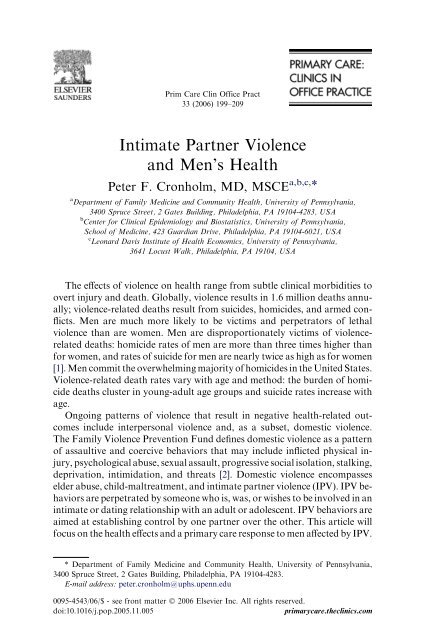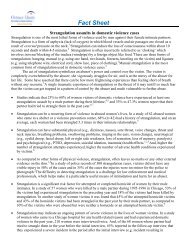Intimate Partner Violence and Men's Health - University of ...
Intimate Partner Violence and Men's Health - University of ...
Intimate Partner Violence and Men's Health - University of ...
You also want an ePaper? Increase the reach of your titles
YUMPU automatically turns print PDFs into web optimized ePapers that Google loves.
Prim Care Clin Office Pract<br />
33 (2006) 199–209<br />
<strong>Intimate</strong> <strong>Partner</strong> <strong>Violence</strong><br />
<strong>and</strong> Men’s <strong>Health</strong><br />
Peter F. Cronholm, MD, MSCE a,b,c, *<br />
a Department <strong>of</strong> Family Medicine <strong>and</strong> Community <strong>Health</strong>, <strong>University</strong> <strong>of</strong> Pennsylvania,<br />
3400 Spruce Street, 2 Gates Building, Philadelphia, PA 19104-4283, USA<br />
b Center for Clinical Epidemiology <strong>and</strong> Biostatistics, <strong>University</strong> <strong>of</strong> Pennsylvania,<br />
School <strong>of</strong> Medicine, 423 Guardian Drive, Philadelphia, PA 19104-6021, USA<br />
c Leonard Davis Institute <strong>of</strong> <strong>Health</strong> Economics, <strong>University</strong> <strong>of</strong> Pennsylvania,<br />
3641 Locust Walk, Philadelphia, PA 19104, USA<br />
The effects <strong>of</strong> violence on health range from subtle clinical morbidities to<br />
overt injury <strong>and</strong> death. Globally, violence results in 1.6 million deaths annually;<br />
violence-related deaths result from suicides, homicides, <strong>and</strong> armed conflicts.<br />
Men are much more likely to be victims <strong>and</strong> perpetrators <strong>of</strong> lethal<br />
violence than are women. Men are disproportionately victims <strong>of</strong> violencerelated<br />
deaths: homicide rates <strong>of</strong> men are more than three times higher than<br />
for women, <strong>and</strong> rates <strong>of</strong> suicide for men are nearly twice as high as for women<br />
[1]. Men commit the overwhelming majority <strong>of</strong> homicides in the United States.<br />
<strong>Violence</strong>-related death rates vary with age <strong>and</strong> method: the burden <strong>of</strong> homicide<br />
deaths cluster in young-adult age groups <strong>and</strong> suicide rates increase with<br />
age.<br />
Ongoing patterns <strong>of</strong> violence that result in negative health-related outcomes<br />
include interpersonal violence <strong>and</strong>, as a subset, domestic violence.<br />
The Family <strong>Violence</strong> Prevention Fund defines domestic violence as a pattern<br />
<strong>of</strong> assaultive <strong>and</strong> coercive behaviors that may include inflicted physical injury,<br />
psychological abuse, sexual assault, progressive social isolation, stalking,<br />
deprivation, intimidation, <strong>and</strong> threats [2]. Domestic violence encompasses<br />
elder abuse, child-maltreatment, <strong>and</strong> intimate partner violence (IPV). IPV behaviors<br />
are perpetrated by someone who is, was, or wishes to be involved in an<br />
intimate or dating relationship with an adult or adolescent. IPV behaviors are<br />
aimed at establishing control by one partner over the other. This article will<br />
focus on the health effects <strong>and</strong> a primary care response to men affected by IPV.<br />
* Department <strong>of</strong> Family Medicine <strong>and</strong> Community <strong>Health</strong>, <strong>University</strong> <strong>of</strong> Pennsylvania,<br />
3400 Spruce Street, 2 Gates Building, Philadelphia, PA 19104-4283.<br />
E-mail address: peter.cronholm@uphs.upenn.edu<br />
0095-4543/06/$ - see front matter Ó 2006 Elsevier Inc. All rights reserved.<br />
doi:10.1016/j.pop.2005.11.005 primarycare.theclinics.com
200 CRONHOLM<br />
Why men are thought <strong>of</strong> as the perpetrators<br />
Annually, approximately 1.5 million women <strong>and</strong> 834,700 men are raped<br />
or physically assaulted in other ways by an intimate partner in the United<br />
States [3]. The National Crime Victimization Survey estimates that 3% <strong>of</strong><br />
IPV incidents result in serious physical injury [4]. In a l<strong>and</strong>mark survey <strong>of</strong><br />
family violence, Straus <strong>and</strong> Gelles [5,6] estimated that 16% <strong>of</strong> couples reported<br />
episodes <strong>of</strong> IPV in the past 12 months <strong>and</strong> 40% <strong>of</strong> these episodes involved<br />
actions such as punching, kicking, or use <strong>of</strong> a weapon.<br />
National surveys, such as the National Family <strong>Violence</strong> Survey <strong>and</strong> surveys<br />
by the Centers for Disease Control <strong>and</strong> Prevention suggest that men <strong>and</strong><br />
women report similar rates <strong>of</strong> IPV or emotional abuse [7,8]. However, national<br />
data support the position that most violence that results in injury, involves<br />
male violence against women, <strong>and</strong> that male-to-female violence tends to be<br />
chronic [9,10]. The National <strong>Violence</strong> Against Women Survey <strong>and</strong> the National<br />
Crime Victimization Survey found that women were more likely than<br />
men to report being IPV victims <strong>and</strong> were twice as likely to be injured in domestic<br />
violence incidents [11,12]. In 95% <strong>of</strong> IPV episodes that led to criminal<br />
investigation, <strong>and</strong> 59% <strong>of</strong> spouse murders, women were the victims [13,14].<br />
It is clinically challenging to separate IPV victimization from perpetration.<br />
The medical model <strong>of</strong> IPV has historically been limited to male perpetration<br />
<strong>of</strong> IPV against female victims in heterosexual relationships. The current<br />
model is rooted in the pro-feminist movement that arose in the 1970s <strong>and</strong><br />
served as the foundation <strong>of</strong> much <strong>of</strong> the work that addressed IPV in the<br />
United States. Overwhelmed health care providers who are faced with increased<br />
dem<strong>and</strong>s <strong>and</strong> an institutional reluctance to address issues shaped<br />
by social determinants, have the perception that addressing IPV is akin to<br />
opening P<strong>and</strong>ora’s Box. Ultimately, a one-dimensional approach is a disservice<br />
to the complexity <strong>of</strong> the manifestation <strong>of</strong> IPV. Men can be victims or<br />
perpetrators <strong>of</strong> IPV in heterosexual, homosexual, or bisexual relationships.<br />
A dramatic association with childhood victimization <strong>and</strong> increased rates<br />
for both perpetration <strong>and</strong> victimization <strong>of</strong> IPV has been shown repeatedly<br />
in the literature [15–17]. Controversial typologies <strong>of</strong> IPV include descriptions<br />
<strong>of</strong> ‘‘mutually aggressive’’ relationships in which both intimate partners perpetrate<br />
<strong>and</strong> are victimized by their behaviors <strong>and</strong> the behaviors <strong>of</strong> their partners.<br />
The complexity <strong>of</strong> describing the manifestations <strong>of</strong> IPV necessitates<br />
that providers conceptualize IPV as an interdigitation <strong>of</strong> victimization <strong>and</strong><br />
perpetration, the distinction between which is <strong>of</strong>ten unclear.<br />
Characteristics <strong>of</strong> victims <strong>and</strong> perpetrators<br />
It remains unclear how men who perpetrate may typically present to clinical<br />
providers. IPV is said to cross all ethnic <strong>and</strong> socioeconomic classes.<br />
However, rates <strong>of</strong> IPV tend to be higher in younger age groups, minority<br />
ethnic groups, <strong>and</strong> lower socioeconomic classes [15,16,18]. Some men may
have no apparent signs <strong>of</strong> IPV-related health consequences; others may be<br />
more obvious. Perpetrators may be more difficult to identify in clinical settings<br />
because they may appear normal <strong>and</strong> healthy in contrast to their partners<br />
who have been devastated by their victimization. Some common<br />
themes in proposed pr<strong>of</strong>iles emerge when perpetrators in treatment are described<br />
as inexpressive, impulse-driven, traditional, <strong>and</strong> rigid with low selfesteem<br />
<strong>and</strong> frequent drug <strong>and</strong> alcohol problems [19]. Other experts have<br />
suggested some <strong>of</strong> the following characteristics may be red-flags for perpetration:<br />
public fronts, controlling behaviors, excuses, bargaining, manipulation,<br />
<strong>and</strong> external locus <strong>of</strong> control [20]. Because no single typology has<br />
successfully predicted who may be perpetrators, identification <strong>of</strong> IPV perpetration<br />
will require a better underst<strong>and</strong>ing <strong>of</strong> how perpetration behaviors<br />
affect men’s health <strong>and</strong> how best to reach men regarding IPV issues.<br />
Why perpetrators perpetrate<br />
There are many theories that have tried to explain perpetration <strong>of</strong> IPV<br />
[21–26]. No one theory can explain why every perpetrator becomes abusive.<br />
From a health care perspective, two concepts are important when trying to<br />
underst<strong>and</strong> perpetration <strong>of</strong> IPV. The first is the concept <strong>of</strong> a cycle <strong>of</strong> violence.<br />
Children who grow up in families where IPV was present are more<br />
likely to become involved in relationships that are affected by IPV. Coker<br />
<strong>and</strong> colleagues [27] found that men were 2.5 times more likely to report exposure<br />
to IPV as adults if they had reported being physically assaulted as<br />
a child. Childhood exposure to violence is associated with increased risk<br />
for future IPV victimization <strong>and</strong> perpetration [6]. Providers need to be sensitive<br />
to the likelihood that men who are identified in clinical practice as IPV<br />
victims or perpetrators will have been exposed to IPV in the past.<br />
A second important perspective explaining IPV victimization <strong>and</strong> perpetration<br />
comes from feminist theory. Feminist theory explains that transmission<br />
<strong>of</strong> IPV is maintained by a normative patriarchal social structure, based<br />
on gender-related power differentials [21,25,26]. It is important for providers<br />
to underst<strong>and</strong> the social constructs <strong>of</strong> behaviors when they identify controlling<br />
behaviors that may be rationalized by patients in terms <strong>of</strong> strong gender<br />
roles. Addressing normative perspectives plays a key role in the treatment <strong>of</strong><br />
IPV perpetration. Curricular content on men’s beliefs about power <strong>and</strong> control<br />
over women is a critical component <strong>of</strong> perpetrator treatment programs.<br />
Programs that include this content are usually contrasted with anger management<br />
programs, which focus primarily on behaviors <strong>and</strong> do not address<br />
underlying causes.<br />
Use <strong>of</strong> health care services<br />
INTIMATE PARTNER VIOLENCE<br />
Although few health care providers screen for the IPV, 15% <strong>of</strong> women<br />
who visited an emergency department, <strong>and</strong> 12%–23% <strong>of</strong> women in family<br />
201
202 CRONHOLM<br />
medicine settings reported having been physically abused or threatened by<br />
their partner within the last year [28–30]. Oriel <strong>and</strong> Fleming [15] reported<br />
that 13.5% <strong>of</strong> male primary care patients in family medicine settings reported<br />
perpetrating minor violence (throwing, pushing, or slapping) over<br />
the past 12 months; 4.2% reported at lease one episode <strong>of</strong> perpetrating severe<br />
violence (kicking, beating, threatening to use or using a knife or<br />
gun). Two studies reported 42%–63% <strong>of</strong> perpetrators had sought care in<br />
a health care setting within the previous 6 months <strong>of</strong> the study [9,31]. Coben<br />
<strong>and</strong> Friedman [31] determined that a large proportion <strong>of</strong> male perpetrators<br />
had been seen by health care pr<strong>of</strong>essionals close to the time they were arrested;<br />
42% <strong>of</strong> men in treatment for IPV perpetration had sought medical<br />
care within the past 6 months. Reasons for seeking health care included issues<br />
related to injury (36%), medical illness (30%), <strong>and</strong> ‘‘check-ups’’ (21%).<br />
<strong>Health</strong> effects<br />
IPV impacts the health <strong>of</strong> victims <strong>and</strong> perpetrators, although less is<br />
known about the effects on perpetrators. Most research has focused on<br />
the health effects <strong>of</strong> IPV victimization on women, but it is reasonable to consider<br />
that a parallel process occurs in men who are IPV victims. IPV victimization<br />
impacts the physical, mental, emotional, social, <strong>and</strong> financial<br />
dimensions <strong>of</strong> health. The burden <strong>of</strong> physical injuries includes contusions,<br />
lacerations, broken bones, <strong>and</strong> death. The psychological consequences <strong>of</strong><br />
abuse can be as important as physical injuries: victims suffer from posttraumatic<br />
stress disorder, <strong>and</strong> abuse victims are more likely than non-abused<br />
persons to be depressed, attempt suicide, abuse alcohol or drugs, <strong>and</strong> transfer<br />
their aggression to their children [32].<br />
In a population-based study, Coker <strong>and</strong> colleagues [27] determined that<br />
men who reported being victims <strong>of</strong> physical abuse, reported increased risk<br />
<strong>of</strong> current poor health, depressive symptoms, substance use, a chronic disease,<br />
chronic mental illness, <strong>and</strong> injury. Men were 1.8 to 2.6 more likely<br />
to report current poor health if they identified low to high levels <strong>of</strong> exposure<br />
to psychological abuse. Moderate physical or sexual IPV was associated<br />
with a tw<strong>of</strong>old increase in the development <strong>of</strong> a chronic disease, <strong>and</strong> high<br />
levels <strong>of</strong> physical, sexual, or psychological IPV was associated with a tw<strong>of</strong>old<br />
increase in rates <strong>of</strong> current depressive symptoms.<br />
A complete model <strong>of</strong> IPV effects on the health <strong>of</strong> a man should include the<br />
effects <strong>of</strong> IPV on his family unit. Those most likely affected are his intimate<br />
partner <strong>and</strong> his children, who may also be our patients in primary care settings.<br />
Children exposed to IPV demonstrate higher levels <strong>of</strong> distress than<br />
non-exposed children [33–35]. Children who witness IPV are more likely to<br />
exhibit behavioral problems such as violence toward peers <strong>and</strong> abuse <strong>of</strong> drugs<br />
<strong>and</strong> alcohol. Running away from home, engaging in teenage prostitution, <strong>and</strong><br />
committing sexual assault crimes, in addition to physical <strong>and</strong> mental health<br />
problems including depression <strong>and</strong> anxiety, are also more likely in children
who witness IPV [36,37]. Internalization <strong>of</strong> distress has been shown to result<br />
in increased rates <strong>of</strong> childhood depression <strong>and</strong> anxiety where externalization<br />
manifests as delinquency <strong>and</strong> aggression [38–41]. Rates <strong>of</strong> child abuse are<br />
extremely high in families affected by IPV, where in 30% to 60% <strong>of</strong> families<br />
affected by IPV, children are also directly abused [6,42,43].<br />
Few studies have examined the health effects <strong>of</strong> men who perpetrate IPV,<br />
<strong>and</strong> the clarity <strong>of</strong> cause <strong>and</strong> effect remain ill defined. An association with increased<br />
rates <strong>of</strong> head injuries is one <strong>of</strong> the few medical conditions that has<br />
repeatedly been related to IPV perpetration [16,18]. More controversy surrounds<br />
the role <strong>of</strong> drug <strong>and</strong> alcohol use in risk for IPV perpetration. Higher<br />
rates <strong>of</strong> drug use <strong>and</strong> alcohol consumption have been well described in perpetration<br />
literature [9,15,18,31,44]. However, experts disagree about whether<br />
drug use or alcohol consumption directly increases the risk <strong>of</strong> perpetration<br />
behaviors or whether alcohol use is a means <strong>of</strong> self-medication in response<br />
to undesired feelings <strong>of</strong> shame, guilt, <strong>and</strong> anxiety by IPV perpetrators [45].<br />
Men who are IPV perpetrators can present in health care settings with<br />
IPV-specific injuries or associated co-morbidities. Gerlock [9] reported<br />
that men in treatment for IPV perpetration used health care systems for<br />
the following symptoms: musculoskeletal (50%), cardiovascular (14%), gastrointestinal<br />
(13%), nervous system (10%), dermatological (10%), <strong>and</strong> pulmonary<br />
(8%) issues. Perpetrators attributed their medical problems, in part,<br />
to their perpetration behaviors <strong>and</strong> nearly a quarter <strong>of</strong> their injuries (lacerations,<br />
bruises, <strong>and</strong> broken bones) were reported to have resulted from IPV.<br />
In addition, perpetrators have higher rates <strong>of</strong> psychiatric problems, including:<br />
depression, anxiety, post-traumatic stress disorder, <strong>and</strong> personality disorders.<br />
Close to one-third <strong>of</strong> perpetrators analyzed believed that their<br />
symptoms <strong>of</strong> depression <strong>and</strong> anxiety resulted from their perpetration<br />
behaviors.<br />
Outreach behaviors<br />
INTIMATE PARTNER VIOLENCE<br />
Help-seeking behaviors <strong>of</strong> perpetrators include self-identification <strong>and</strong><br />
self-referral to health care or other pr<strong>of</strong>essional service providers. In addition,<br />
perpetrators may seek advice <strong>and</strong> support from family <strong>and</strong> friends.<br />
A study <strong>of</strong> IPV help-seeking strategies in a Milwaukee community sample<br />
<strong>of</strong> self-identified IPV victims <strong>and</strong> their partners [28] determined that informal<br />
help-sources for victims included family members, in-laws, neighbors,<br />
<strong>and</strong> friends; formal help-sources for victims included the police, social service<br />
agencies, lawyers <strong>and</strong> district attorneys, the clergy, <strong>and</strong> women’s<br />
groups. A striking finding <strong>of</strong> this study was that the more contact the perpetrator<br />
had with their friends, the less likely they were to make an effort<br />
to end the violence in the relationship. This finding suggested the existence<br />
<strong>of</strong> a ‘‘peer subculture’’ that normatively supports IPV. Bowker [28] reports<br />
that 69% <strong>of</strong> female IPV victims reported that their husb<strong>and</strong>s made at least<br />
203
204 CRONHOLM<br />
one contact with a formal or informal help-source in an attempt to end the<br />
abuse.<br />
Pr<strong>of</strong>essional service outreach behaviors include identification by screening<br />
men for perpetration <strong>of</strong> IPV in asymptomatic populations as well as<br />
secondary responses to signs concerning perpetration <strong>of</strong> IPV. Outreach<br />
behaviors may also include support, counseling, referral to community<br />
agencies or mental health providers, <strong>and</strong> treatment <strong>of</strong> co-morbidities. Little<br />
is known about outreach behaviors <strong>of</strong> primary care providers concerning<br />
perpetration <strong>of</strong> IPV <strong>and</strong> even less about how they might relate to the<br />
help-seeking behaviors <strong>of</strong> perpetrators.<br />
How to identify victimization <strong>and</strong> perpetration in men<br />
Sugg <strong>and</strong> coworkers [46] conducted one <strong>of</strong> the few studies that included<br />
issues related to identifying perpetration in the primary care setting. She<br />
found that 10% <strong>of</strong> primary care providers reported that they never identified<br />
an IPV victim <strong>and</strong> 55% reported that they never identified an IPV perpetrator.<br />
She was also able to demonstrate discordance between reported<br />
IPV prevalence rates <strong>and</strong> provider’s perceptions <strong>of</strong> IPV prevalence in their<br />
practices. Most primary care providers reported that IPV was rare or very<br />
rare (1% <strong>and</strong> 0.1%) at their site. Reported rates <strong>of</strong> IPV prevalence increased<br />
when providers were asked about their health care system in general. This<br />
finding supports providers’ <strong>of</strong>ten cited misperception that IPV is not an issue<br />
in their practice.<br />
Identifying IPV in male patients is a burgeoning area <strong>of</strong> clinical research.<br />
As suggested earlier, a significant proportion <strong>of</strong> patients presenting in primary<br />
care settings report IPV victimization <strong>and</strong> perpetration within the<br />
past 12 months. Clinical protocols originally used for identification <strong>of</strong> female<br />
victimization have been adapted for clinical identification <strong>of</strong> male victimization<br />
<strong>and</strong> perpetration. In clinical settings, multiple short screening<br />
instruments have been shown to be valid identifiers <strong>of</strong> domestic violence,<br />
but most simply ask patients if they feel safe in their relationships <strong>and</strong> if anyone<br />
is abusing them physically, sexually, or emotionally. RADAR st<strong>and</strong>s<br />
for Routine inquiry, Ask direct questions, Document findings, Assess patient<br />
safety <strong>and</strong> lethality, <strong>and</strong> Respond, Review options <strong>and</strong> Refer, <strong>and</strong><br />
was created by the Massachusetts Medical Society <strong>and</strong> further developed<br />
into a training program by the Institute for Safe Families <strong>of</strong> Philadelphia.<br />
RADAR has been used effectively to provide clinicians with a useful approach<br />
for the identification <strong>and</strong> treatment <strong>of</strong> male victims <strong>and</strong> perpetrators<br />
<strong>of</strong> IPV [47].<br />
Guidelines developed to address IPV when both partners are patients in<br />
the same primary care setting concluded that it was not a conflict <strong>of</strong> interest<br />
to address IPV with both partners, but that this should be done independently<br />
with the safety <strong>of</strong> the victim at the forefront [48]. When concerned<br />
about perpetration, it may be best to approach the victimized partner first
INTIMATE PARTNER VIOLENCE<br />
to get permission to approach this subject with the perpetrating partner in<br />
addition to discussing safety issues with the victimized partner. Each provider<br />
has their own personal style when asking about sensitive issues <strong>and</strong><br />
the exact wording is not as important as the fact that pertinent questions<br />
are asked. Providers may also want to notify the patient <strong>of</strong> exceptions to<br />
confidentiality. Specifically, if children are being harmed, the appropriate<br />
authority will need to be notified, <strong>and</strong> if there is an imminent risk to the patient<br />
or someone else, the police may need to be involved.<br />
An effective practice is to combine funneling techniques with direct questions,<br />
without being judgmental. Funneling techniques involve starting with<br />
more general <strong>and</strong> less sensitive questions or statements that guide the discussion<br />
toward more sensitive issues. For example, ‘‘All people argue. How do<br />
you <strong>and</strong> your partner h<strong>and</strong>le disagreements or fights?’’ ‘‘Do your disagreements<br />
or fights ever become physical?’’ ‘‘Are you in a relationship in which<br />
you are being hurt or threatened?’’ ‘‘Have you ever used any kind <strong>of</strong> physical<br />
force against your partner?’’ ‘‘Has your partner ever pushed, grabbed,<br />
slapped, choked, or hit you?’’ ‘‘Have you ever done that to her/him?’’<br />
‘‘Has your partner ever forced you to have sex or perform sexual acts which<br />
you did not want to do?’’ ‘‘Have you done that to her/him?’’<br />
When men say yes to intimate partner violence<br />
When a provider has identified behaviors suggestive <strong>of</strong> IPV, it is important<br />
to document what was asked <strong>and</strong> the patient’s response. Quotation<br />
marks should be used to document exact words <strong>and</strong> notes about observed<br />
injuries, if any, should be made. The provider should make an assessment<br />
<strong>of</strong> the potential for future violence including threats made. Describe safety<br />
<strong>and</strong> follow-up plans including the next scheduled appointment. A safety <strong>and</strong><br />
lethality assessment involves determining the risk to the patient <strong>and</strong> their<br />
contacts after leaving the clinical encounter. Increases in the frequency or<br />
severity <strong>of</strong> violence, stalking behaviors, weapon use <strong>and</strong> accessibility, prior<br />
contact with the police or a Protection From Abuse Order, substance abuse,<br />
depression, or mental illness exacerbating behavior have all been associated<br />
with higher risk for homicide in relationships affected by IPV [49,50]. Finally,<br />
it is important to document that the provider asked about the safety <strong>of</strong> children<br />
in the home.<br />
When a provider encounters an IPV victim, he should be encouraged to<br />
talk about it. The provider should validate his experience, emphasize the<br />
risk <strong>of</strong> violence to him <strong>and</strong> his families’ health <strong>and</strong> well-being, acknowledge<br />
that change is a process, <strong>and</strong> follow the situation over time. If the patient<br />
does not need immediate assistance, he should be <strong>of</strong>fered information about<br />
resources in the community.<br />
A health care provider who encounters IPV perpetration should positively<br />
reinforce the patient’s willingness to communicate the situation, <strong>and</strong> reframe<br />
the issue as a health issue. It is important to not condone the behavior <strong>and</strong><br />
205
206 CRONHOLM<br />
to educate the patient about the consequences <strong>of</strong> his abusive behavior. A provider<br />
can <strong>of</strong>fer hope that the patient can change his behavior <strong>and</strong> <strong>of</strong>fer appropriate<br />
referrals, recognize that change is a process, <strong>and</strong> follow the pattern <strong>of</strong><br />
behavior over time. Finally, the provider should make referrals <strong>and</strong> schedule<br />
a follow-up appointment.<br />
Treatment <strong>of</strong> perpetration<br />
Most IPV experts who have worked with men who are abusive would<br />
strongly support referral to a community-based batterer intervention program<br />
(BIP). BIP st<strong>and</strong>ards vary from state to state, but a few themes are<br />
common. Programs should: last for 6–12 months; monitor <strong>and</strong> confront<br />
abusive behaviors; screen for substance <strong>and</strong> mental health issues <strong>and</strong> <strong>of</strong>fer<br />
referrals; identify the range <strong>of</strong> behaviors common to most batterers; teach<br />
avoidance techniques <strong>and</strong> responsibility plans; use content on men’s belief<br />
about power <strong>and</strong> control over women; employ staff trained to work with<br />
women battering issues; develop linkages with domestic violence agencies<br />
<strong>and</strong> strong coordination with the criminal justice system [51].<br />
Whether BIPs are effective is frequently debated. Recent studies have reviewed<br />
the literature on screening for IPV [31,44]. There has been a dearth<br />
<strong>of</strong> sound evidence to support any medical intervention to reduce IPV. IPV<br />
has not been addressed adequately by researchers using rigorous methodological<br />
approaches. Recent meta-analyses, <strong>and</strong> a study using propensity<br />
scores to address some <strong>of</strong> the methodological challenges, have suggested<br />
that BIPs can be effective in reducing IPV recidivism [52,53].<br />
Ferris <strong>and</strong> colleagues [54] studied scenarios where both the man <strong>and</strong> the<br />
woman were the provider’s patients, <strong>and</strong> demonstrated that the provider’s<br />
relationship with a male partner was a stronger predictor <strong>of</strong> provider action<br />
than clinical signs <strong>of</strong> abuse in the female partner. If the provider identified<br />
the provider-perpetrator relationship as ‘‘good,’’ providers were more likely<br />
to make a risky recommendation, such as discussing the issue with the couple<br />
or referring patients for couples counseling; both <strong>of</strong> which may put the<br />
victim at increased risk for abuse.<br />
Although a minority <strong>of</strong> providers sampled believed they had strategies<br />
for helping IPV victims, 64% thought they had strategies that could help<br />
perpetrators. Just over one-third <strong>of</strong> providers were confident about how<br />
to refer domestic violence victims <strong>and</strong> even less (22%) were confident about<br />
how to refer perpetrators [15]. For effective referral, it is important for providers<br />
to be aware <strong>of</strong> community resources that address IPV with men.<br />
Physicians who view perpetration as a disease may be more likely to refer<br />
to psychotherapy or counseling rather than a batter intervention program<br />
[55]. Mental health disorders <strong>and</strong> substance abuse are more common in samples<br />
<strong>of</strong> perpetrators when compared with non-perpetrators; however, most<br />
are without a diagnosis. Couples counseling is generally contraindicated<br />
in relationships affected by IPV [10,19,51]. A major concern is that couples
counseling is <strong>of</strong>ten an attempt to work out the couple’s problems within the<br />
context <strong>of</strong> the relationship <strong>and</strong> does not address the issues <strong>of</strong> power <strong>and</strong><br />
control that led to the abuse. It is important not to endorse processes that<br />
blame the victim. Most experts would strongly recommend avoidance <strong>of</strong><br />
couples counseling until there has been a sustained violence-free period <strong>of</strong><br />
6–9 months.<br />
Summary<br />
There is little evidence to guide providers in what to do regarding men<br />
<strong>and</strong> IPV. It is important to appreciate that there may never be a time<br />
when the evidence supporting routine identification <strong>of</strong> IPV will reach the<br />
level <strong>of</strong> evidence for guidelines addressing colon cancer screening or use<br />
<strong>of</strong> aspirin in the prevention <strong>of</strong> cardiovascular morbidity <strong>and</strong> mortality.<br />
IPV is a highly complex issue that historically has been a moving target<br />
with high social domains. However, a plausible argument can be made for<br />
endorsing the role <strong>of</strong> primary care providers in the identification <strong>and</strong> referral<br />
<strong>of</strong> men for IPV-related issues. When a provider identifies <strong>and</strong> refers men for<br />
IPV-related issues, there is the potential to increase the safety <strong>of</strong> men’s intimate<br />
partners <strong>and</strong> children, to interrupt the cycle <strong>of</strong> violence that perpetuates<br />
the transgenerational diffusion <strong>of</strong> abusive behaviors, <strong>and</strong> to reduce the<br />
associated negative social <strong>and</strong> health effects that IPV has on men’s lives.<br />
Given the high prevalence <strong>of</strong> IPV among patients in primary care <strong>of</strong>fices<br />
<strong>and</strong> the development <strong>of</strong> effective treatments for men who are perpetrators<br />
<strong>of</strong> IPV, it is reasonable for primary care providers to begin to ask questions<br />
<strong>of</strong> their male patients regarding IPV that can lead to the prevention <strong>of</strong> <strong>and</strong><br />
early intervention for perpetration <strong>of</strong> IPV.<br />
Acknowledgments<br />
The author thanks Joseph B. Straton, MD, MSCE, for his helpful comments<br />
<strong>and</strong> suggestions.<br />
References<br />
INTIMATE PARTNER VIOLENCE<br />
[1] World report on violence <strong>and</strong> health: summary. Geneva (Switzerl<strong>and</strong>): World <strong>Health</strong> Organization;<br />
2002. p. 45.<br />
[2] Family <strong>Violence</strong> Prevention Fund. National consensus guidelines on identifying <strong>and</strong> responding<br />
to domestic violence victimization in health care settings. San Francisco (CA):<br />
Family <strong>Violence</strong> Prevention Fund; 2004.<br />
[3] Tjaden P, Thoennes N. Prevalence, incidence, <strong>and</strong> consequences <strong>of</strong> violence against women:<br />
findings from the natinal violence against women survey. Washington, DC: U.S. Department<br />
<strong>of</strong> Justice, National Institute <strong>of</strong> Justice; 2000.<br />
[4] Bachman R. <strong>Violence</strong> against women: a national crime victimization survey report. Washington,<br />
DC: Bureau <strong>of</strong> Justice Statistics, US Department <strong>of</strong> Justice; 1994.<br />
[5] Straus MA, Gelles RJ, Steinmetz SK. Behind closed doors: violence in the American family.<br />
1st edition. Garden City (NY): Anchor Press/Doubleday; 1980.<br />
207
208 CRONHOLM<br />
[6] Straus MA, Gelles RJ. Physical violence in American families. New Brunswick (NJ): Transaction<br />
Publishers; 1990.<br />
[7] Strauss M, Gelles R. Societal change <strong>and</strong> change in family violence from 1975 to 1986 as revealed<br />
by two national surveys. J Marriage Fam 1987;48:465–79.<br />
[8] Centers for Disease Control <strong>and</strong> Prevention. <strong>Intimate</strong> partner violence among men <strong>and</strong><br />
women - South Carolina. MMWR 1998;49(3):691–4.<br />
[9] Gerlock AA. <strong>Health</strong> impact <strong>of</strong> domestic violence. Issues Ment <strong>Health</strong> Nurs 1999;20(4):<br />
373–85.<br />
[10] Cascardi M, Langhinrichsen J, Vivian D. Marital aggression: impact, injury, <strong>and</strong> health<br />
correlates for husb<strong>and</strong>s <strong>and</strong> wives. Arch Intern Med 1992;152(6):1178–84.<br />
[11] Tjaden P, Thoennes N. Prevalence <strong>and</strong> consequences <strong>of</strong> male-to-female <strong>and</strong> female-to-male<br />
intimate partner violence as measured by the national violence against women survey. <strong>Violence</strong><br />
Against Women 2000;6(2):142–61.<br />
[12] Bachman R, Saltzman L. <strong>Violence</strong> against women: estimates from the redesigned survey.<br />
Washington, DC: National Institute <strong>of</strong> Justice, Bureau <strong>of</strong> Justice Statistics; 1995.<br />
[13] Elliott BA, Johnson MM. Domestic violence in a primary care setting. Arch Fam Med 1995;<br />
4:113–9.<br />
[14] Dawson JM, Langan PA. Murder in families. Special report. Washington, DC: US Department<br />
<strong>of</strong> Justice, Bureau <strong>of</strong> Justice Statistics; 1994.<br />
[15] Oriel KA, Fleming MF. Screening men for partner violence in a primary care setting. A new<br />
strategy for detecting domestic violence. J Fam Pract 1998;46(6):493–8.<br />
[16] Murphy CM. Treating perpetrators <strong>of</strong> adult domestic violence. Md Med J 1994;43(10):<br />
877–83.<br />
[17] Fitch FJ, Papantonio A. Men who batter: some pertinent characteristics. Compr Psychiatry<br />
1992;33:411–6.<br />
[18] Bacaner N, Kinney TA, Biros M, et al. The relationship among depressive <strong>and</strong> alcoholic<br />
symptoms <strong>and</strong> aggressive behavior in adult male emergency department patients. Acad<br />
Emerg Med 2002;9(2):120–9.<br />
[19] Dutton DG, Golant SK. The batterer: a psychological pr<strong>of</strong>ile. New York: Basic Books; 1995.<br />
[20] Hanusa D. The next step: focusing on abusers in the health care system. Wis Med J 1998;<br />
97(4):60–1.<br />
[21] Dobash RE, Dobash RP. Wives: the appropriate victims <strong>of</strong> marital violence. Victimology<br />
1977;2:426–42.<br />
[22] Dutton DG. The abusive personality: violence <strong>and</strong> control in intimate relationships. New<br />
York: The Guilford Press; 1998.<br />
[23] Jacobson NS, Gottman JM. When men batter women: new insights into ending abusive<br />
relationships. New York: Simon <strong>and</strong> Schuster; 1998.<br />
[24] Gelles RJ, Straus MA. <strong>Intimate</strong> violence: the causes <strong>and</strong> consequences <strong>of</strong> abuse in the American<br />
family. New York: Simon <strong>and</strong> Schuster; 1988.<br />
[25] Schechter S. An agenda for the battered women’s movement: internal issues. In: Women <strong>and</strong><br />
male violence: the visions <strong>and</strong> struggles <strong>of</strong> the battered women’s movement. Boston: South<br />
End Press; 1982.<br />
[26] McCall GJ, Shields NM. Social <strong>and</strong> structural factors in family violence. In: Lystad M,<br />
editor. <strong>Violence</strong> in the home: interdisciplinary perspectives. New York: Brunner/Mazel,<br />
Inc; 1986. p. 98–123.<br />
[27] Coker AL, et al. Physical <strong>and</strong> mental health effects <strong>of</strong> intimate partner violence for men <strong>and</strong><br />
women. Am J Prev Med 2002;23(4):260–8.<br />
[28] Bowker LH. Beating wife-beating. Lexington (MA): Lexington Books; 1983.<br />
[29] Gelles RJ, Straus MA. <strong>Intimate</strong> violence. New York: Simon & Schuster; 1989.<br />
[30] Abbott J, Johnson R, Koziol-McLain J, et al. Domestic violence against women: incidence<br />
<strong>and</strong> prevalence in an emergency department population [comment]. JAMA 1995;273(22):<br />
1763–7.
INTIMATE PARTNER VIOLENCE<br />
[31] Coben JH, Friedman DI. <strong>Health</strong> care use by perpetrators <strong>of</strong> domestic violence. J Emerg Med<br />
2002;22(3):313–7.<br />
[32] Campbell JC. <strong>Health</strong> consequences <strong>of</strong> intimate partner violence. Lancet 2002;359(9314):<br />
1331–6.<br />
[33] Holden GW. Introduction. In: Holden GW, Geffner R, Jouriles EN, editors. Children exposed<br />
to marital violence. Washington (DC): American Psychological Association; 1998. p. 1–18.<br />
[34] McCloskey LA, Figueredo AJ, Koss MP. The effects <strong>of</strong> systemic family violence on children’s<br />
mental health. Child Dev 1995;66:1239–61.<br />
[35] Jouriles EN, Norwood WD. Physical aggression towards boys <strong>and</strong> girls in familes characterized<br />
by the battering <strong>of</strong> women. J Fam Psychol 1995;9:69–78.<br />
[36] Jaffe P, Sudermann M. Child witness <strong>of</strong> women abuse: research <strong>and</strong> community responses.<br />
In: Stith S, Straus M, editors. Underst<strong>and</strong>ing partner violence: prevalence, causes, consequences,<br />
<strong>and</strong> solutions. Families in focus services, Vol. II. Minneapolis (MN): National<br />
Council on Family Relations; 1995.<br />
[37] Wolfe DA, et al. Strategies to address violence in the lives <strong>of</strong> high risk youth. In: Peled E, Jaffe<br />
PG, Edleson JL, editors. Ending the cycle <strong>of</strong> violence: community responses to children <strong>of</strong><br />
battered women. Newbury Park, CA: Sage Publications; 1995.<br />
[38] Kolbo JR, Blakely EH, Engelman D. Children who witness domestic violence: a review <strong>of</strong><br />
empirical literature. J Interpers <strong>Violence</strong> 1996;11:281–93.<br />
[39] Fantuzzo J, Lindquist C. The effects <strong>of</strong> observing conjugal violence on children: a review <strong>of</strong><br />
the empirical literature. J Fam <strong>Violence</strong> 1989;4:77–94.<br />
[40] Hughes HM, Parkinson D, Vargo M. Witnessing spouse abuse <strong>and</strong> experiencing physical<br />
abuse: a ‘‘double whammy?’’ J Fam <strong>Violence</strong> 1989;4:197–209.<br />
[41] O’Keefe M. The differential effects <strong>of</strong> family violence on adolescent adjustment. Child Adolesc<br />
Social Work J 1996;13:51–68.<br />
[42] Edleson JL. The overlap between child maltreatment <strong>and</strong> woman battering. <strong>Violence</strong><br />
Against Women 1999;5(2):134–54.<br />
[43] Christian CW, Scribano P, Seidle T, et al. Pediatric injury resulting from family violence. Pediatrics<br />
1997;99(2):E8.<br />
[44] Dinwiddie SH. Psychiatric disorders among wife batterers. Compr Psychiatry 1992;33(6):<br />
411–6.<br />
[45] Mintz HA, Cornett FW. When your patient is a batterer. What you need to know before<br />
treating perpetrators <strong>of</strong> domestic violence. Postgrad Med 1997;101(4):219–21, 225–8.<br />
[46] Sugg NK, Thompson RS, Thompson DC, et al. Domestic violence <strong>and</strong> primary care. Attitudes,<br />
practices, <strong>and</strong> beliefs. Arch Fam Med 1999;8(4):301–6.<br />
[47] O’Campo P, Gielen AC, Faden RR, et al. Verbal abuse <strong>and</strong> physical violence among a cohort<br />
<strong>of</strong> low-income pregnant women. Womens <strong>Health</strong> Issues 1994;4(1):29–37.<br />
[48] Ferris LE, Norton PG, Dunn EV, et al. Guidelines for managing domestic abuse when male<br />
<strong>and</strong> female partners are patients <strong>of</strong> the same physician. The Delphi Panel <strong>and</strong> the Consulting<br />
Group. JAMA 1997;278(10):851–7.<br />
[49] Campbell J, Webster D, Koziol-McLain J, et al. Risk factors for femicide in abusive relationships:<br />
results from a multisite case control study. Am J Public <strong>Health</strong> 2003;93(7):1089–97.<br />
[50] Wilson M, Daly M. Spousal homicide risk <strong>and</strong> estrangement. <strong>Violence</strong> Vict 1993;8(1):3–16.<br />
[51] Gondolf E. Identifying <strong>and</strong> assessing men who batter. In: Assessing woman battering in<br />
mental health services. Thous<strong>and</strong> Oakes (CA): Sage Publications; 1998. p. 132–156.<br />
[52] Jones AS, D’Agostino RB Jr, Gondolf EW, et al. Assessing the effect <strong>of</strong> batterer program<br />
completion on reassault using propensity scores. J Interpers <strong>Violence</strong> 2004;19(9):1002–20.<br />
[53] Tolman RM, Bennett LW. A review <strong>of</strong> quantitative research on men who batter. J Interpers<br />
<strong>Violence</strong> 1990;5:87–118.<br />
[54] Ferris LE, Norton P, Dunn EV, et al. Clinical factors affecting physicians’ management<br />
decisions in cases <strong>of</strong> female partner abuse. Fam Med 1999;31(6):415–25.<br />
[55] Adams D. Guidelines for doctors on identifying <strong>and</strong> helping their patients who batter. J Am<br />
Med Womens Assoc 1996;51(3):123–6.<br />
209










